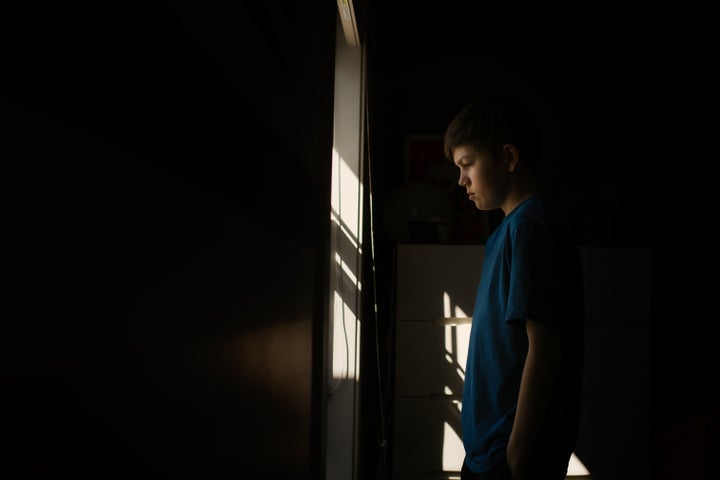
As temperatures dip and days get shorter around this time of year, it’s not uncommon to experience the “winter blues.” But for many people, these negative feelings and behaviors are signs of something more serious ― seasonal depression, also known as seasonal affective disorder or SAD.
“Seasonal affective disorder is a type of depression that occurs around certain times of year when there’s less sunlight ― which is typically correlated with the change in seasons, depending on where you live,” explained Neha Chaudhary, a child and adolescent psychiatrist at Massachusetts General Hospital and Harvard Medical School, and an adviser at the behavioral health platform Brightline.
While people tend to associate seasonal affective disorder with adults, some parents have observed it in children. But can children experience SAD? And if so, what does it look like? Below, experts share their insights.
Can kids have SAD?
“It is possible for children to have SAD, just as it’s possible for them to have anxiety, depression and other concerns,” said Margaret Cochran, a psychotherapist and licensed clinical social worker based in San Jose, California. “It can develop in younger children, but it most frequently manifests, as do many other disorders, around the time puberty begins.”
Sue Varma, a clinical assistant professor of psychiatry at NYU Langone Medical Center, noted that she’s observed seasonal depression more in older children aged 10-12, teens and young adults. She also said it’s observed more often in girls than in boys.
“In general, females are twice as likely to get depression, and two to four times as likely for seasonal depression,” she said.
What signs should parents look for?
“Symptoms of SAD are similar to those of depression but appear during specific times of year (late fall until early spring), which is how it differs from traditional depression,” explained Jennifer L. Hartstein, a New York-based child, adolescent and family psychologist.
She noted that signs of SAD may include mood changes like increased sadness or irritability, feelings of hopelessness or worthlessness, increased sensitivity or self-criticism, decreased energy, changes in sleeping and/or eating patterns, trouble focusing, lack of motivation, loss of interest in things that they used to enjoy, and increased isolation or disconnection from friends and others.
Some kids may feel heavy in their bodies, not want to get out of bed, or avoid going outside. They may be more clingy or need extra reassurance.
Additionally, the isolation of our COVID-19 world, with its increased screen time, remote learning and decreased physical activity, can also worsen the winter blues and make it harder to separate SAD from more general pandemic struggles. Pay attention to significant or sudden shifts in your child and whether their timing has a seasonal nature.
“When it comes to the way that SAD presents, there are a predictable group of symptoms. However, please bear in mind that not every child will demonstrate all the symptoms on this list and that what you need to look for are changes in your daughter or son‘s usual demeanor,” Cochran explained.
What should you do if you think your child has SAD?
While you may feel tempted to simply wait until the seasons change again, it’s important to address mental health issues in kids, especially if your child’s symptoms are impacting their academic performance, self-esteem, friendships or ability to function every day.
“Parents who suspect their child is suffering from SAD should reach out to a professional for help, like a pediatrician, therapist or even school counselor, to start,” recommended Chaudhary.
A comprehensive medical and psychological evaluation can help identify the problem, whether it’s bullying, substance abuse, SAD or other medical issues like vitamin deficiency, vision issues, thyroid problems or other illnesses that can present as depression.
“I can’t stress enough that while pandemic stress, seasonal blues and plain old adolescence might be the issue, children may be limited in identifying and attributing to the cause. I’d hate for a parent to miss some other underlying cause,” Varma noted.
As we all navigate the stress of the continuing pandemic, it’s important for parents to take a moment for self-care as well.
“Whilst also thinking about your children and the impact on them, parents should also think about the impact on themselves,” noted U.K.-based psychotherapist Noel McDermott. “As they say in the safety talk on planes before takeoff, make sure you put the oxygen mask on yourself first.”
How is SAD treated in children?
There are different ways to address SAD in children, and the options can vary based on how mild or severe the case is.
“A first line of defense is to increase light exposure,” Hartstein said. “Get outside during the day, even if you have to bundle up, and get more vitamin D and exposure to sunlight. For mild cases, this change alone can have lasting benefits.”
More serious symptoms may call for phototherapy, or light therapy. Many doctors recommend using daylight replacement bulbs and putting special SAD lamps, also known as light therapy boxes in the space where your child does virtual learning or homework after school.
“Another thing that helps is healthy exercise, such as running around the local park,” noted McDermott. “That might be more difficult with your teens, but organizing family activities outside can be done.”
Beyond healthy habits and special lamps, there are psychological interventions that can help young people navigate seasonal depression.
“Psychotherapy is often recommended, as is medication management,” Hartstein said. “One piece of SAD is a decrease in serotonin levels, which can be treated pharmacologically. Talk therapy can help young people work through their feelings and help them to shift their negative thinking into more helpful thoughts.”